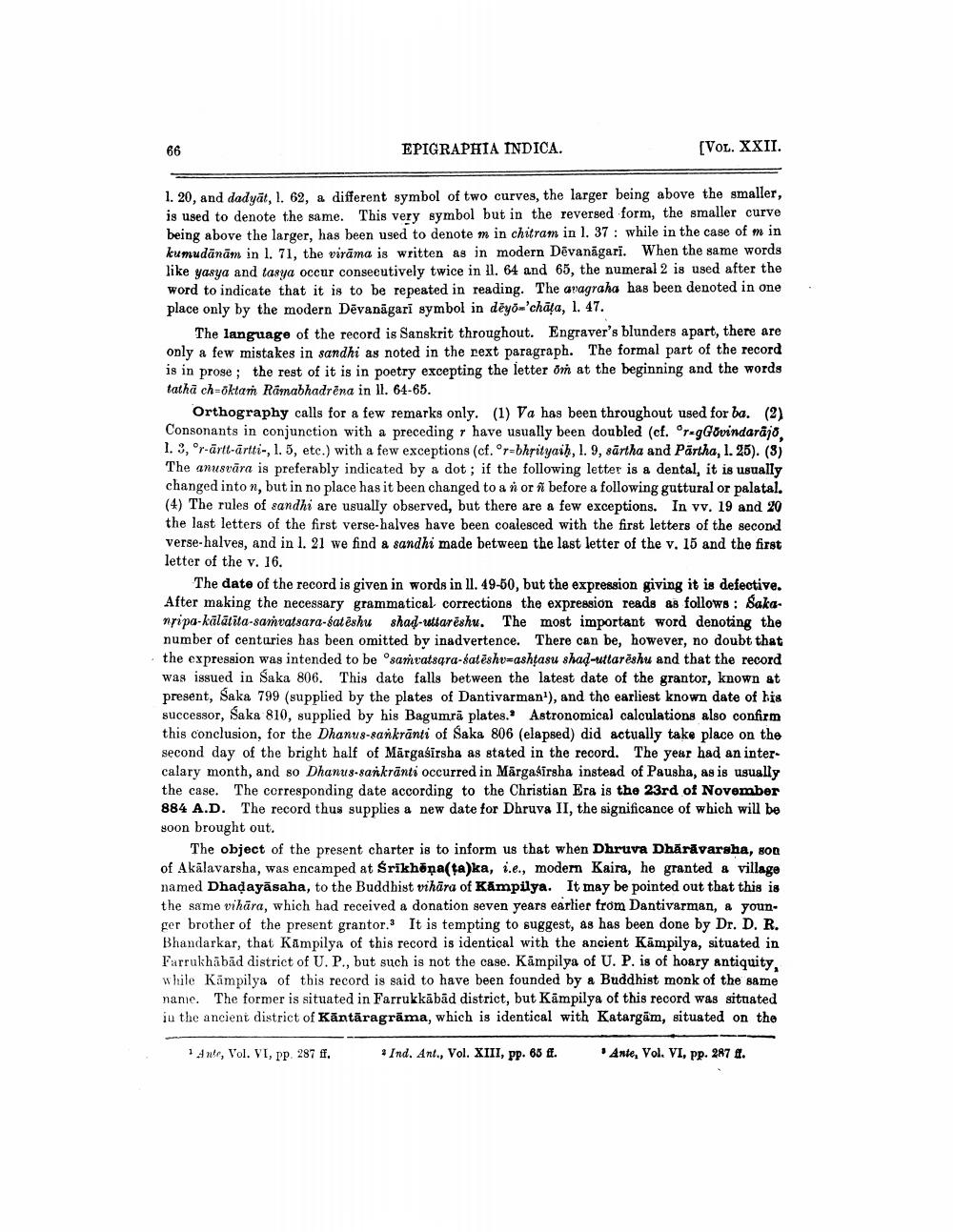________________
66
EPIGRAPHIA INDICA.
[VOL. XXII.
1. 20, and dadyāt, 1. 62, a different symbol of two curves, the larger being above the smaller, is used to denote the same. This very symbol but in the reversed form, the smaller curve being above the larger, has been used to denote m in chitram in l. 37 : while in the case of min kumudānām in 1. 71, the virāma is written as in modern Dēvanagari. When the same words like yasya and tasya occur consecutively twice in 11. 64 and 65, the numeral 2 is used after the word to indicate that it is to be repeated in reading. The avagraha has been denoted in one place only by the modern Dēvanāgari symbol in deyor'chāļa, 1. 47.
The language of the record is Sanskrit throughout. Engraver's blunders apart, there are only a few mistakes in sandhi as noted in the rext paragraph. The formal part of the record is in prose; the rest of it is in poetry excepting the letter om at the beginning and the words tatha ch-oktam Ramabhadrēna in 11. 64-65.
Orthography calls for a few remarks only. (1) Va has been throughout used for ba. (2) Consonants in conjunction with a preceding have usually been doubled (cf.or=gGovindarajo. 1.3, or-ārtt-artti-, 1.5, etc.) with a few exceptions (cf.or=bhrityaih, 1. 9, sārtha and Partha, 1.25). (3) The anusvāra is preferably indicated by a dot; if the following letter is a dental, it is usually changed into n, but in no place has it been changed to a n or n before a following guttural or palatal. (4) The rules of sandhi are usually observed, but there are a few exceptions. In vv. 19 and 20 the last letters of the first verse-halves have been coalesced with the first letters of the second verse-halves, and in l. 21 we find a sandhi made between the last letter of the v. 15 and the first letter of the v. 16.
The date of the record is given in words in 11. 49-50, but the expression giving it is defective. After making the necessary grammatical corrections the expression reads as follows: Sakanripa-kālātīta-samvatsara-latëshu shad-uttarēshu. The most important word denoting the number of centuries has been omitted by inadvertence. There can be, however, no doubt that the expression was intended to be samvatsara-satēshu=ashțasu shad-uttarëshu and that the record was issued in Saka 806. This dato falls between the latest date of the grantor, known at present, Saka 799 (supplied by the plates of Dantivarman"), and the earliest known date of his successor, Saka 810, supplied by his Bagumrā plates. Astronomical calculations also confirm this conclusion, for the Dhanus-sankranti of Saka 806 (elapsed) did actually take place on the second day of the bright half of Mārgasirsha as stated in the record. The year had an intercalary month, and so Dhanus-sankranti occurred in Mārgasīrsha instead of Pausha, as is usually the case. The corresponding date according to the Christian Era is the 23rd of November 884 A.D. The record thus supplies a new date for Dhruva II, the significance of which will be soon brought out.
The object of the present charter is to inform us that when Dhruva Dhārāvarsha, son of Akālavarsha, was encamped at Srikhona(ta)ka, i.e., modern Kaira, he granted & village named Dhadayāsaha, to the Buddhist vihāra of Kāmpilya. It may be pointed out that this is the same vihāra, which had received a donation seven years earlier from Dantivarman, a younger brother of the present grantor. It is tempting to suggest, as has been done by Dr. D. R. Bhandarkar, that Kampilya of this record is identical with the ancient Kampilya, situated in Farrukhābād district of U. P., but such is not the case. Kāmpilya of U. P. is of hoary antiquity, while Kāmpilya of this record is said to have been founded by a Buddhist monk of the same nanie. The former is situated in Farrukkābād district, but Kāmpilya of this record was situated in the ancient district of Kāntāragrāma, which is identical with Katargām, situated on the
Antr, Vol. VI, PP. 287 ff.
* Ind. Ant., Vol. XIII, pp. 65 ff.
Ante, Vol. VI, pp. 287 f.




